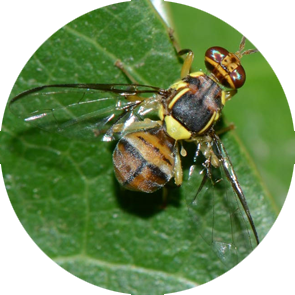


| Latin Name | Bactrocera dorsalis |
| Common Name | Oriental fruit fly |
| Biology | Adults exhibit diurnal activity and are strong fliers, ovipositing within citrus, mango, and other fruit tissues. Larvae bore into fruits and feed internally, causing rotting and premature fruit drop – a critical pest threatening tropical and subtropical horticulture. |
| Damage | This pest primarily damages citrus, mango, guava, lychee and other fruits. |
| Distribution Regions | Subtropical fruit area |
| Monitoring | Pheromone lures mimic natural sex pheromones to attract male insects into specialized traps for population monitoring and suppression. As a core IPM component, monitoring enables early risk detection and targeted control. Mass trapping reduces mating opportunities to curb offspring populations. Protocols: ●Use only with matched traps. ●15-45 traps/hectare,replace/replenish every 4-6 weeks. ●Wear gloves or wash hands with detergent when switching lure types. ●Refer to trap-specific hanging instructions. |
| Recommended Traps | Fruit Fly Trap |

Partagez vos coordonnées pour recevoir des solutions à phéromones adaptées avec précision. Si notre portefeuille existant ne propose pas la solution optimale, notre équipe de chimie de synthèse lancera un développement sur mesure – de la conception de la structure moléculaire à la production à grande échelle.